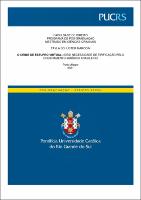| Share record |


|
Please use this identifier to cite or link to this item:
https://tede2.pucrs.br/tede2/handle/tede/10082Full metadata record
| DC Field | Value | Language |
|---|---|---|
| dc.creator | Marodin, Tayla Schuster | - |
| dc.creator.Lattes | http://lattes.cnpq.br/7901887134388155 | por |
| dc.contributor.advisor1 | Souza Júnior, Ney Fayet de | - |
| dc.contributor.advisor1Lattes | http://lattes.cnpq.br/3904638241201962 | por |
| dc.date.accessioned | 2022-02-10T14:14:15Z | - |
| dc.date.issued | 2021-03-26 | - |
| dc.identifier.uri | http://tede2.pucrs.br/tede2/handle/tede/10082 | - |
| dc.description.resumo | A presente dissertação aborda uma nova conduta que vem sendo enquadrada no tipo penal de estupro, advindo da Lei 12.015/2009, que acabou por considerar em um mesmo artigo a conjunção carnal como outros atos contra a liberdade sexual. A nova conduta trazida, entendida por estupro virtual, trouxe muitas dúvidas quanto à aplicação adequada da lei neste tipo de situação. Por isso, o objetivo deste trabalho é analisar a necessidade ou não de tipificação pelo ordenamento jurídico brasileiro do estupro virtual. O trabalho possui a estrutura de três capítulos, sendo que o primeiro é introdutório aos conceitos de crimes virtuais e o surgimento da internet; o segundo traz as alterações da Lei 12.015/2009, bem como a intenção do legislador com as referidas mudanças; e o terceiro voltou-se exclusivamente para a análise do crime de estupro virtual e a tipicidade da conduta, analisando também o princípio da legalidade. Analisa-se no percorrer do trabalho que há posicionamentos distintos, sendo que alguns acreditam que possa ocorrer a configuração deste crime nos artigos 213 e 217-A, enquanto de outro lado e majoritariamente, entendem que para haver o crime configurado é necessário o contato físico. Diante disso, através da tecnologia e dos crimes virtuais, foi realizado um levantamento acerca da possibilidade de enquadramento pelo estupro virtual, a fim de entender a necessidade ou não da presença física. Foi possível concluir com este trabalho que o meio virtual é apenas um instrumento que se pode utilizar para se chegar ao cometimento do crime de estupro, já que é necessária a presença física do sujeito para configuração de tal crime. Por isso, é desproporcional aceitar a pena privativa de liberdade para todo e qualquer caso que venha ser entendido como estupro virtual. | por |
| dc.description.abstract | This dissertation addresses a new conduct that has been framed in the criminal type of rape, arising from Law 12,015 / 2009, which ended up considering in the same article the carnal conjunction as other acts against sexual freedom. The new conduct brought, understood by virtual rape, raised many doubts about the proper application of the law in this type of situation. Therefore, the objective of this work is to analyze the need or not of typification by the Brazilian legal system of virtual rape. The work has the structure of three chapters, the first of which is introductory to the concepts of virtual crimes and the emergence of the internet; the second brings the amendments to Law 12,015 / 2009, as well as the intention of the legislator with the referred changes; and the third focused exclusively on the analysis of the crime of virtual rape and the typical nature of the conduct, also analyzing the principle of legality. It is analyzed in the course of the work that there are different positions, and some believe that the configuration of this crime can occur in articles 213 and 217-A, while on the other hand and mostly, they understand that to have the crime configured, physical contact is necessary . Therefore, through technology and virtual crimes, a survey was carried out on the possibility of being framed by virtual rape, in order to understand the need or not of physical presence. It was possible to conclude with this work that the virtual environment is just an instrument that can be used to arrive at the commission of the crime of rape, since the physical presence of the subject is necessary to configure such a crime. For this reason, it is disproportionate to accept the custodial sentence for any and all cases that may be understood as virtual rape. | eng |
| dc.description.provenance | Submitted by PPG Ciências Criminais ([email protected]) on 2022-02-09T18:44:00Z No. of bitstreams: 1 TAYLA_SCHUSTER_MARODIN_DIS.pdf: 1586229 bytes, checksum: 2bf6139ff5c4200bace5e6891b2b96cf (MD5) | eng |
| dc.description.provenance | Approved for entry into archive by Sheila Dias ([email protected]) on 2022-02-10T14:00:10Z (GMT) No. of bitstreams: 1 TAYLA_SCHUSTER_MARODIN_DIS.pdf: 1586229 bytes, checksum: 2bf6139ff5c4200bace5e6891b2b96cf (MD5) | eng |
| dc.description.provenance | Made available in DSpace on 2022-02-10T14:14:15Z (GMT). No. of bitstreams: 1 TAYLA_SCHUSTER_MARODIN_DIS.pdf: 1586229 bytes, checksum: 2bf6139ff5c4200bace5e6891b2b96cf (MD5) Previous issue date: 2021-03-26 | eng |
| dc.format | application/pdf | * |
| dc.thumbnail.url | http://tede2.pucrs.br:80/tede2/retrieve/183277/TAYLA_SCHUSTER_MARODIN_DIS.pdf.jpg | * |
| dc.language | por | por |
| dc.publisher | Pontifícia Universidade Católica do Rio Grande do Sul | por |
| dc.publisher.department | Escola de Direito | por |
| dc.publisher.country | Brasil | por |
| dc.publisher.initials | PUCRS | por |
| dc.publisher.program | Programa de Pós-Graduação em Ciências Criminais | por |
| dc.rights | Acesso Aberto | por |
| dc.subject | Estupro | por |
| dc.subject | Crime | por |
| dc.subject | Virtual | por |
| dc.subject | Novo Tipo Penal | por |
| dc.subject | Estupro Virtual | por |
| dc.subject | Cibercrime | por |
| dc.subject | Tecnologia | por |
| dc.subject.cnpq | CIENCIAS SOCIAIS APLICADAS::DIREITO | por |
| dc.title | O crime de estupro virtual : (des) necessidade de tipificação pelo ordenamento jurídico brasileiro | por |
| dc.type | Dissertação | por |
| dc.restricao.situacao | Trabalho não apresenta restrição para publicação | por |
| Appears in Collections: | Programa de Pós-Graduação em Ciências Criminais | |
Files in This Item:
| File | Description | Size | Format | |
|---|---|---|---|---|
| TAYLA_SCHUSTER_MARODIN_DIS.pdf | TAYLA_SCHUSTER_MARODIN_DIS | 1.55 MB | Adobe PDF |  Download/Open Preview |
Items in DSpace are protected by copyright, with all rights reserved, unless otherwise indicated.




